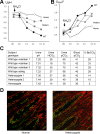Incomplete distal renal tubular acidosis from a heterozygous mutation of the V-ATPase B1 subunit
- PMID: 25164082
- PMCID: PMC4216985
- DOI: 10.1152/ajprenal.00408.2014
Incomplete distal renal tubular acidosis from a heterozygous mutation of the V-ATPase B1 subunit
Abstract
Congenital distal renal tubular acidosis (RTA) from mutations of the B1 subunit of V-ATPase is considered an autosomal recessive disease. We analyzed a distal RTA kindred with a truncation mutation of B1 (p.Phe468fsX487) previously shown to have failure of assembly into the V1 domain of V-ATPase. All heterozygous carriers in this kindred have normal plasma HCO3- concentrations and thus evaded the diagnosis of RTA. However, inappropriately high urine pH, hypocitraturia, and hypercalciuria were present either individually or in combination in the heterozygotes at baseline. Two of the heterozygotes studied also had inappropriate urinary acidification with acute ammonium chloride loading and an impaired urine-blood Pco2 gradient during bicarbonaturia, indicating the presence of a H+ gradient and flux defects. In normal human renal papillae, wild-type B1 is located primarily on the plasma membrane, but papilla from one of the heterozygote who had kidney stones but not nephrocalcinosis showed B1 in both the plasma membrane as well as diffuse intracellular staining. Titration of increasing amounts of the mutant B1 subunit did not exhibit negative dominance over the expression, cellular distribution, or H+ pump activity of wild-type B1 in mammalian human embryonic kidney-293 cells and in V-ATPase-deficient Saccharomyces cerevisiae. This is the first demonstration of renal acidification defects and nephrolithiasis in heterozygous carriers of a mutant B1 subunit that cannot be attributable to negative dominance. We propose that heterozygosity may lead to mild real acidification defects due to haploinsufficiency. B1 heterozygosity should be considered in patients with calcium nephrolithiasis and urinary abnormalities such as alkalinuria or hypocitraturia.
Keywords: V-ATPase; distal renal tubular acidosis; haploinsufficiency; kidney stones.
Copyright © 2014 the American Physiological Society.
Figures






Similar articles
-
Changes in V-ATPase subunits of human urinary exosomes reflect the renal response to acute acid/alkali loading and the defects in distal renal tubular acidosis.Kidney Int. 2018 Apr;93(4):871-880. doi: 10.1016/j.kint.2017.10.018. Epub 2018 Jan 6. Kidney Int. 2018. PMID: 29310826 Free PMC article.
-
Vacuolar H+ -ATPase B1 subunit mutations that cause inherited distal renal tubular acidosis affect proton pump assembly and trafficking in inner medullary collecting duct cells.J Am Soc Nephrol. 2006 Jul;17(7):1858-66. doi: 10.1681/ASN.2005121277. Epub 2006 Jun 12. J Am Soc Nephrol. 2006. PMID: 16769747
-
Pathophysiology, diagnosis and treatment of inherited distal renal tubular acidosis.J Nephrol. 2018 Aug;31(4):511-522. doi: 10.1007/s40620-017-0447-1. Epub 2017 Oct 9. J Nephrol. 2018. PMID: 28994037 Review.
-
Familial renal tubular acidosis.J Nephrol. 2010 Nov-Dec;23 Suppl 16:S57-76. J Nephrol. 2010. PMID: 21170890 Review.
-
The B1-subunit of the H(+) ATPase is required for maximal urinary acidification.Proc Natl Acad Sci U S A. 2005 Sep 20;102(38):13616-21. doi: 10.1073/pnas.0506769102. Epub 2005 Sep 8. Proc Natl Acad Sci U S A. 2005. PMID: 16174750 Free PMC article.
Cited by
-
Incomplete Distal Renal Tubular Acidosis and Kidney Stones.Adv Chronic Kidney Dis. 2018 Jul;25(4):366-374. doi: 10.1053/j.ackd.2018.05.007. Adv Chronic Kidney Dis. 2018. PMID: 30139463 Free PMC article. Review.
-
The genetics of kidney stone disease and nephrocalcinosis.Nat Rev Nephrol. 2022 Apr;18(4):224-240. doi: 10.1038/s41581-021-00513-4. Epub 2021 Dec 14. Nat Rev Nephrol. 2022. PMID: 34907378 Review.
-
Clinical and laboratory approaches in the diagnosis of renal tubular acidosis.Pediatr Nephrol. 2015 Dec;30(12):2099-107. doi: 10.1007/s00467-015-3083-9. Epub 2015 Apr 1. Pediatr Nephrol. 2015. PMID: 25823989 Review.
-
Distal renal tubular acidosis: genetic causes and management.World J Pediatr. 2019 Oct;15(5):422-431. doi: 10.1007/s12519-019-00260-4. Epub 2019 May 11. World J Pediatr. 2019. PMID: 31079338 Review.
-
Proteomic changes in response to crystal formation in Drosophila Malpighian tubules.Fly (Austin). 2016 Apr 2;10(2):91-100. doi: 10.1080/19336934.2016.1171947. Epub 2016 Apr 11. Fly (Austin). 2016. PMID: 27064297 Free PMC article.
References
-
- Arampatzis S, Ropke-Rieben B, Lippuner K, Hess B. Prevalence and densitometric characteristics of incomplete distal renal tubular acidosis in men with recurrent calcium nephrolithiasis. Urol Res 40: 53–59, 2012 - PubMed
-
- Backman U, Danielson BG, Johansson G, Ljunghall S, Wikstrom B. Incidence and clinical importance of renal tubular defects in recurrent renal stone formers. Nephron 25: 96–101, 1980 - PubMed
-
- Bajaj G, Quan A. Renal tubular acidosis and deafness: report of a large family. Am J Kidney Dis 27: 880–882, 1996 - PubMed
-
- Brenner RJ, Spring DB, Sebastian A, McSherry EM, Genant HK, Palubinskas AJ, Morris RC, Jr. Incidence of radiographically evident bone disease, nephrocalcinosis, and nephrolithiasis in various types of renal tubular acidosis. N Engl J Med 307: 217–221, 1982 - PubMed
Publication types
MeSH terms
Substances
Grants and funding
LinkOut - more resources
Full Text Sources
Other Literature Sources
Molecular Biology Databases

